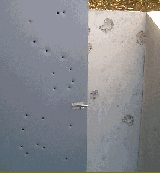 Yes, those are bullet holes from an automatic weapon, and no, this picture was not taken in a war zone. I took it just a few days ago along the shore of an undeveloped lake located near Washington State’s Tahuya forest. This now bullet-riddled outhouse had been placed beside the lake as a public service and is designed like a concrete bomb shelter specifically to take the abuse the public was going to dish out. Instead of providing inexpensive and easily replaced facilities, someone had decided to build an outhouse version of the Maginot line. I cannot imagine what it must have cost to put there. As I hiked that day, the silence had been interrupted on occasion by the distant sound of gunfire. I walked lightly, always ready to reverse course should I stumble onto a meth lab or a car being stripped, which I have witnessed on more than one occasion over the years. Contrary to what one might expect, hiking in Washington’s state-forest hinterlands can be an unnerving experience. Part of the reason I was visiting that day was to repair gates on my forest property that had been smashed by an off-road enthusiast.
Yes, those are bullet holes from an automatic weapon, and no, this picture was not taken in a war zone. I took it just a few days ago along the shore of an undeveloped lake located near Washington State’s Tahuya forest. This now bullet-riddled outhouse had been placed beside the lake as a public service and is designed like a concrete bomb shelter specifically to take the abuse the public was going to dish out. Instead of providing inexpensive and easily replaced facilities, someone had decided to build an outhouse version of the Maginot line. I cannot imagine what it must have cost to put there. As I hiked that day, the silence had been interrupted on occasion by the distant sound of gunfire. I walked lightly, always ready to reverse course should I stumble onto a meth lab or a car being stripped, which I have witnessed on more than one occasion over the years. Contrary to what one might expect, hiking in Washington’s state-forest hinterlands can be an unnerving experience. Part of the reason I was visiting that day was to repair gates on my forest property that had been smashed by an off-road enthusiast.
 Beside this same lake, nailed to a tree just out of reach were two signs: one from the Washington Department of Natural Resources (DNR) and the other from the US department of Fish and Wildlife. The DNR sign read, “Campfires Not Permitted.” Oddly enough, the remains of several bonfires, half buried under beer cans, were strewn all about. A similar scene greeted me at the next lake I visited.
Beside this same lake, nailed to a tree just out of reach were two signs: one from the Washington Department of Natural Resources (DNR) and the other from the US department of Fish and Wildlife. The DNR sign read, “Campfires Not Permitted.” Oddly enough, the remains of several bonfires, half buried under beer cans, were strewn all about. A similar scene greeted me at the next lake I visited.
Finally, I hiked to a large, isolated pond a few miles into the forest. The logging road to this pond has been blocked for years by a “tank trap” (a series of deep ditches perpendicular to the road) but someone had managed to circumvent it. I found that an off-road vehicle had driven right through the shallow end of the pond, leaving a trail of devastation.
 The Tahuya forest is trust land. It exists primarily to make money for the state. However, I am not convinced that it should be the government’s responsibility to turn areas of our forests into amusement parks, providing and maintaining trails and facilities for horses, dirt bikes, and other assorted off-road vehicles. I also do not see why the U.S. Department of Fish and Wildlife should be dumping trout into lakes specifically so the public can amuse themselves by catching them again. There is something almost comical about the idea. It would be more cost effective to provide barrels of fish with beer holders attached to the sides.
The Tahuya forest is trust land. It exists primarily to make money for the state. However, I am not convinced that it should be the government’s responsibility to turn areas of our forests into amusement parks, providing and maintaining trails and facilities for horses, dirt bikes, and other assorted off-road vehicles. I also do not see why the U.S. Department of Fish and Wildlife should be dumping trout into lakes specifically so the public can amuse themselves by catching them again. There is something almost comical about the idea. It would be more cost effective to provide barrels of fish with beer holders attached to the sides.
Would entrepreneurs build dirt-bike and off-road parks, fishing holes, and duck ponds to meet demand for them if the government got out of the business? From my perspective, efforts to provide the public with “recreation” are trumping the need to protect the forest’s natural ecosystems and wildlife.
Several years ago, a private party purchased a lake in this same area. I breathed a sigh of relief when he chose to build a lodge at one end that caters to catch-and-release fly fishermen, rather than destroy the lake by ringing it with a housing development. He has also allowed public access so the locals can continue to swim and fish there. In stark contrast to the government-managed lakes described above, there are no campfire remains or bullet holes at this privately managed one.
 Yes, those are bullet holes from an automatic weapon, and no, this picture was not taken in a
Yes, those are bullet holes from an automatic weapon, and no, this picture was not taken in a 
